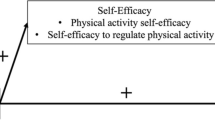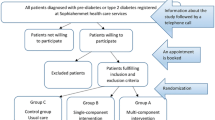Abstract
Despite evidence of the benefits of physical activity, most individuals with type 2 diabetes do not meet physical activity recommendations. The purpose of this study was to test the efficacy of a brief intervention targeting self-efficacy and self-regulation to increase physical activity in older adults with type 2 diabetes. Older adults (Mage = 61.8 ± 6.4) with type 2 diabetes or metabolic syndrome were randomized into a titrated physical activity intervention (n = 58) or an online health education course (n = 58). The intervention included walking exercise and theory-based group workshops. Self-efficacy, self-regulation and physical activity were assessed at baseline, post-intervention, and a follow-up. Results indicated a group by time effect for self-regulation [F(2,88) = 14.021, p < .001, η 2 = .24] and self-efficacy [F(12,77) = 2.322, p < .05, η 2 = .266] with increases in the intervention group. The intervention resulted in short-term increases in physical activity (d = .76, p < .01), which were partially maintained at the 6-month follow-up (d = .35, p < .01). The intervention increased short-term physical activity but was not successful at maintaining increases in physical activity. Similar intervention effects were observed in self-efficacy and self-regulation. Future research warrants adjusting intervention strategies to increase long-term change.




Similar content being viewed by others
References
Bandura, A. (1986). Social foundations of thought and action: A social cognitive theory. New Jersey: Prentice Hall.
Bandura, A. (1997). Self-efficacy: The exercise of control. New York: Freeman.
Bandura, A. (2005). The primacy of self-regulation in health promotion. Applied Psychology, 54(2), 245–254.
Brawley, L. R., Rejeski, W. J., & King, A. C. (2003). Promoting physical activity for older adults: The challenges for changing behavior. American Journal of Preventive Medicine, 25(3Sii), 172–183.
Centers for Disease Control and Prevention. (2011). National diabetes fact sheet: national estimates and general information on diabetes and prediabetes in the United States, 2011. Retrieved from http://www.cdc.gov/diabetes/pubs/pdf/ndfs_2011.pdf
Centers for Disease Control and Prevention. (2013). Press Release: One in five adults meets overall physical activity guidelines. Retrieved from http://www.cdc.gov/media/releases/2013/p0502-physical-activity.html
Copeland, J. L. (2009). Accelerometer assessment of physical activity in active, healthy older adults. Journal of Aging and Physical Activity, 17, 17–30.
de Jager, C. A., Budge, M. M., & Clarke, R. (2003). Utility of TICS-M for the assessment of cognitive function in older adults. International Journal of Geriatric Psychiatry, 18, 318–324.
Diabetes Prevention Program Research Group. (2002). Reduction of the incidence of type 2 diabetes with lifestyle intervention or metformin. New England Journal of Medicine, 346(6), 393–403.
Dishman, R. K. (1982). Compliance/adherence in health-related exercise. Health Psychology, 1, 237–267.
Dishman, R. K., Motl, R. W., Sallis, J. F., Dunn, A. L., Birnbaum, A. S., Welk, G. J., et al. (2005). Self-management strategies mediate self-efficacy and physical activity. American Journal of Preventive Medicine, 29(1), 10–18.
Duncan, G. E., Perri, M. G., Theriaque, D. W., Hutson, A. D., Eckel, R. H., & Stacpoole, P. W. (2003). Exercise training, without weight loss, increases insulin sensitivity and postherparin plasma lipase activity in previously sedentary adults. Diabetes Care, 26, 557–562. doi:10.2337/diacare.26.3.557
Freedson, P. S., Melanson, E., & Sirand, J. (1998). Calibration of the computer science and applications, inc. accelerometer. Medicine and Science in Sports and Exercise, 30, 777–781.
Grundy, S. M., Cleeman, J. I., Daniels, S. R., Donato, K. A., Eckel, R. H., Franklin, B. A., et al. (2005). Diagnosis and management of the metabolic syndrome: An American Heart Association/National Heart, Lung, and Blood Institute scientific statement. Circulation, 112, 2735–2752.
Jeon, C. Y., Looken, R. P., Hu, F. B., & van Dam, R. M. (2007). Physical activity of moderate intensity and risk of type 2 diabetes: A systematic review. Diabetes Care, 30, 744–752.
Lally, P., Van Jaarsveld, C. H. M., Potts, H. W. W., & Wardle, J. (2010). How are habits formed: Modeling habit formation in the real world. European Journal of Social Psychology, 40, 998–1009.
Lerman, I. (2005). Adherence to treatment: The key for avoiding long-term complications of diabetes. Archives of Medical Research, 36, 300–306.
Luciano, E., Carneiro, E. M., Carvalho, C. R., Carvalheira, J. B., Peres, S. B., Reis, M. A., et al. (2002). Endurance training improves responsiveness to insulin and modulates insulin signaling transduction through the phosphatidylinositol 3-kinase/Akt-1 pathway. European Journal of Endocrinology, 147, 149–157. doi:10.1530/eje.0.1470149
Maes, S., & Karoly, P. (2005). Self-regulation assessment and intervention in physical health and illness: A review. Applied Psychology, 54(2), 267–299.
Mailey, E. L., Gothe, N. P., Wójcicki, T. R., Szabo, A. N., Olson, E. A., Mullen, S. P., et al. (2014). Influence of allowable interruption period on estimates of accelerometer wear time and sedentary time in older adults. Journal of Aging and Physical Activity, 22(2), 255–260. doi:10.1123/japa.2013-0021
Masse, L., Fummeler, B., Anderson, C., Mathews, C., Trost, S., Catellier, D., et al. (2005). Accelerometer data reduction: A comparison of four reduction algorithms on select outcome variables. Medicine and Science in Sports and Exercise, 37(11), S544–S554.
Matos, A., Ropelle, E. R., Pauli, J. R., Frederico, M. J. S., de Pinho, R. A., Velloso, L. A., & De Souza, C. T. (2010). Acute exercise reverses TRB3 expression in the skeletal muscle and ameliorates whole body insulin sensitivity in diabetic mice. Acta Physiologica, 198, 61–69. doi:10.1111/j.1748-1716.2009.02031.x
McAuley, E. (1992). The role of efficacy cognitions in the prediction of exercise behavior in middle-aged adults. Journal of Behavorial Medicine, 15(1), 65–88.
McAuley, E., & Blissmer, B. (2000). Self-efficacy determinants and consequences of physical activity. Exercise and Sport Science Reviews, 28(2), 85–88.
McAuley, E., Blissmer, B., Katula, J., Duncan, T. E., & Mihalko, S. L. (2000). Physical activity, self-esteem, and self-efficacy relationships in older adults: A randomized controlled trial. Annals of Behavioral Medicine, 22, 131–139.
McAuley, E., Hall, K. S., Motl, R. W., White, S. M., Wójcicki, T. R., Hu, L., & Doerksen, S. E. (2009). Trajectory of declines in physical activity in community-dwelling older women: Social cognitive influences. Journals of Gerontology, Series B: Psychological Sciences, 64B(5), 543–550. doi:10.1093/geronb/gbp049
McAuley, E., Jerome, G. J., Marquez, D. X., Elavsky, S., & Blissmer, B. (2003). Exercise self-efficacy in older adults: Social, affective and behavioral influences. Annals of Behavioral Medicine, 25, 1–7. doi:10.1207/S15324796ABM2501_01
McAuley, E., Lox, C., & Duncan, T. E. (1993). Long-term maintenance of exercise, self-efficacy, and physiologic change in older adults. Journals of Gerontology, Series B: Psychological Sciences, 48(4), 218–224.
McAuley, E., Mailey, E. L., Mullen, S. P., Szabo, A. N., Wójckicki, T. R., White, S. M., et al. (2011). Growth trajectories of exercise self-efficacy in older adults: Influence of measures and initial status. Health Psychology, 30(1), 75–83. doi:10.1037/a0021567
McAuley, E., & Mihalko, S. L. (1998). Measuring exercise-related self-efficacy. In J. L. Duda (Ed.), Advances in sport and exercise psychology measurement. Fitness Information Technology: West Virginia.
McBean, A. M., Gilbertson, D. T., Li, S., & Collins, A. J. (2004). Differences in diabetes prevalence, incidence, and mortality among the elderly of four racial/ethnic groups: White, Blacks, Hispanics, and Asians. Diabetes Care, 27, 2317–2324.
Moore, S. M., Charvat, J. M., Gordon, N. H., Pashkow, F., Ribisl, P., Roberts, B. L., & Rocco, M. (2006). Effects of a CHANGE intervention to increase exercise maintenance following cardiac events. Annals of Behavioral Medicine, 31, 53–62. doi:10.1207/s15324796abm3101_9
Morrato, E. H., Hill, J. O., Wyatt, H. R., Ghushchyan, V., & Sullivan, P. W. (2007). Physical activity in the U.S. adults with diabetes and at risk for developing diabetes, 2003. Diabetes Care, 30(2), 203–209.
Nwasuruba, C. K., Khan, M., & Egede, L. E. (2007). Racial/ethnic differences in multiples self-care behaviors in adults with diabetes. Journal of General Internal Medicine, 22, 115–120.
Rejeski, W. J., Marsh, A. P., Chmelo, E., Prescott, A. J., Dobrosielski, M., Walkup, M. P., et al. (2009). The lifestyle interventions and independence for elders pilot (LIFE-P): 2-year follow-up. Journals of Gerontology, Series A: Biological Sciences, 64A(4), 462–467.
Resnick, H., Harris, M., Brock, D., & Harris, T. (2000). American Diabetes Association diabetes diagnostic criteria, advancing age and cardiovascular disease risk profiles. Diabetes Care, 23, 176–180.
Rogers, L. Q., Hopkins-Price, P., Vicari, S., Markwell, S., Pamenter, R., Courneya, K. S., et al. (2009a). Physical activity and health outcomes three months after completing a physical activity behavior change intervention: Persistent and delayed effects. Cancer Epidemiology, Biomarkers and Prevention, 18, 1410–1418.
Rogers, L. Q., Hopkins-Price, P., Vicari, S., Pamenter, R., Courneya, K. S., Markwell, S., et al. (2009b). A randomized trial to increase physical activity in breast cancer survivors. Medicine and Science in Sports and Exercise, 41(4), 935–936. doi:10.1249/MSS.0b013e31818e0e1b
Sigal, R. J., Kenny, G. P., Wasserman, D. H., Castaneda-Sceppa, C., & White, R. D. (2006). Physical activity/exercise and type 2 diabetes: A consensus statement from the American Diabetes Association. Diabetes Care, 29(6), 1433–1438.
The LIFE Study Investigators. (2006). Effects of a physical activity intervention on measures of physical performance: Results of the lifestyle interventions and independence for elders pilot (LIFE-P) study. Journals of Gerontology, Series A: Biological Sciences, 61A(11), 1157–1165.
Touati, S., Meziri, F., Devaux, S., Berthelot, A., Touyz, R., & Laurent, P. (2011). Exercise reverses metabolic syndrome in high-fat diet-induced obese rats. Medicine and Science in Sports and Exercise, 43(3), 398–407. doi:10.1249/MSS.0b013e3181eeb12d
Umstattd, M. R., Motl, R. W., Wilcox, S., Saunders, R., & Watford, M. (2009). Measuring physical activity self-regulation strategies in older adults. Journal of Physical Activity and Health, 6, S105–S112.
Wing, R. R., Goldstein, M. G., Acton, K. J., Birch, L. L., Jakicic, J. M., Sallis, J. F., et al. (2001). Behavioral science research in diabetes: Lifestyle changes related to obesity, eating behavior, and physical activity. Diabetes Care, 24, 117–123.
Acknowledgments
Research was funded by: National Institute on Aging: F31 AG042232, R01 AG0200118, 5T32AG023480-10; and by the Shahid Khan and Ann Carlson Khan Endowed Professorship. Funding sources had no involvement in research design; data collection, analysis or interpretation; manuscript writing; or decision to submit for publication. Authors have no financial disclosures.
Author information
Authors and Affiliations
Corresponding author
Ethics declarations
Conflict of interest
Erin A. Olson and Edward McAuley declare no conflict of interest.
Human and animal rights and Informed Consent
All procedures followed were in accordance with the ethical standards of the responsible committee on human experimentation (institutional and national) and with the Helsinki Declaration of 1975, as revised in 2000. Informed consent was obtained from all participants for being included in the study.
Rights and permissions
About this article
Cite this article
Olson, E.A., McAuley, E. Impact of a brief intervention on self-regulation, self-efficacy and physical activity in older adults with type 2 diabetes. J Behav Med 38, 886–898 (2015). https://doi.org/10.1007/s10865-015-9660-3
Received:
Accepted:
Published:
Issue Date:
DOI: https://doi.org/10.1007/s10865-015-9660-3




